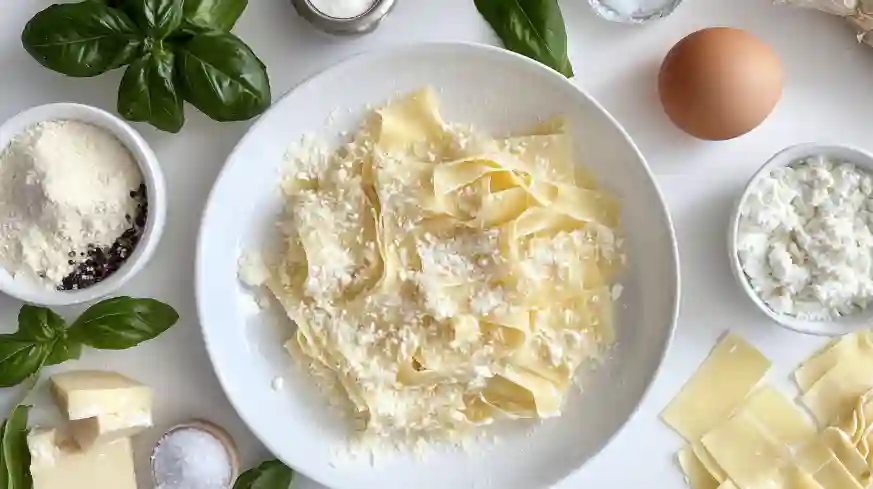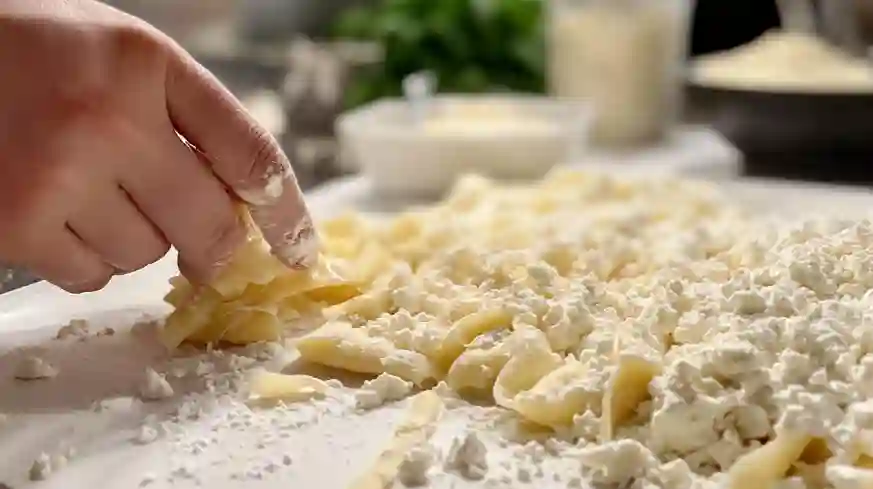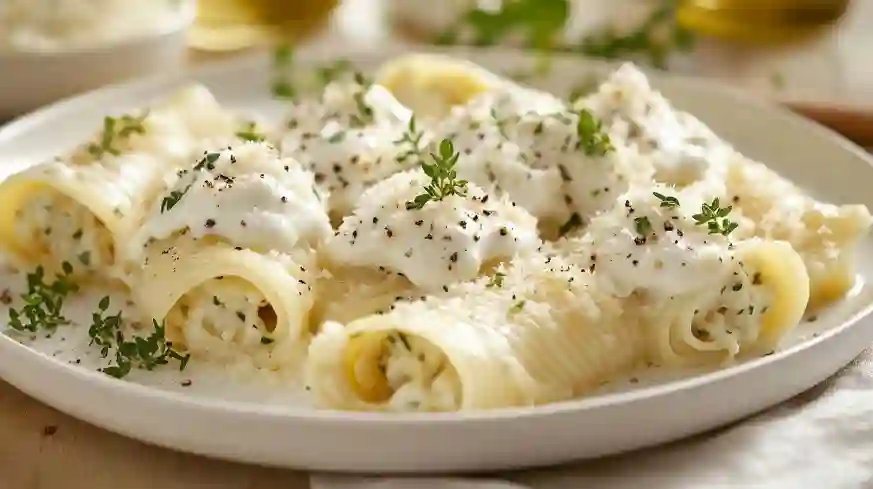There’s a quiet elegance in sacchetti pasta—those delicate, drawstring-shaped “little purses” that seem to hold more than just filling; they carry centuries of tradition, charm, and indulgent flavor. The first time I tasted sacchetti, it felt like unwrapping a culinary gift. Each bite revealed a creamy burst of cheese and herbs, wrapped in a tender, pillowy casing that dissolved effortlessly on the tongue. It was love at first forkful.
Sacchetti, also known as sacchettini, originates from Northern Italy and is aptly named for its pouch-like shape, which means “little bags” in Italian. Unlike other stuffed pastas that aim for uniformity, sacchetti celebrates a rustic, hand-tied appearance—each one slightly unique, like artisanal treasures crafted with care.
What makes this pasta so special is its versatility and richness. These tiny purses are designed to cradle luxurious fillings like ricotta, gorgonzola, truffles, mushrooms, or even pear-infused cheeses. When paired with a delicate butter sauce or a rich cream reduction, sacchetti offers a restaurant-quality experience that’s surprisingly achievable at home.
Whether you’re making it from scratch or finding it fresh at an Italian market, sacchetti is more than a pasta—it’s a celebration of craftsmanship and flavor in every elegant bite.
Sacchetti Pasta Greatest
Course: DinnerCuisine: ItalianDifficulty: Easy4
servings10
minutes15
minutes~520 kcal per serving
kcalDelicate cheese-filled sacchetti pasta tossed in a rich, creamy Parmesan sauce for an irresistible Italian classic
Ingredients
For the Sacchetti Pasta (store-bought or homemade)
500g sacchetti pasta (cheese-filled or ricotta-spinach stuffed)
For the Sauce
2 tablespoons unsalted butter
2 tablespoons olive oil
2 cloves garlic, minced
1 shallot, finely chopped
150ml heavy cream
100ml vegetable or chicken broth
1/3 cup grated Parmesan cheese
Salt and black pepper to taste
Pinch of nutmeg (optional)
Optional Add-ins
100g diced prosciutto or pancetta (for a savory twist)
1 cup baby spinach (for freshness)
Toasted pine nuts (for crunch)
Fresh sage or basil leaves (for garnish)
Extra grated Parmesan (for serving)
Directions
- Cook the Sacchetti Pasta
Bring a large pot of salted water to a boil.
Add the sacchetti pasta and cook according to the package instructions (usually 3–5 minutes for fresh pasta) until al dente.
Drain and set aside, reserving ½ cup of pasta water. - Prepare the Sauce
In a large skillet over medium heat, melt the butter with olive oil.
Add the minced garlic and chopped shallot; sauté for 1–2 minutes until fragrant and translucent. - Deglaze and Simmer
Pour in the broth and bring to a simmer for 2–3 minutes.
Stir in the heavy cream and let it gently bubble for another 2–3 minutes, reducing slightly.
Add Parmesan cheese and stir until melted and the sauce thickens.
Season with salt, black pepper, and a pinch of nutmeg (if using). - Combine Pasta and Sauce
Add the cooked sacchetti to the sauce.
Toss gently to coat the pasta evenly. If the sauce is too thick, loosen with a splash of reserved pasta water. - Optional Add-ins
For added flavor, stir in sautéed prosciutto or pancetta.
Toss in fresh baby spinach and cook just until wilted.
Sprinkle with toasted pine nuts for texture. - Serve
Plate the pasta hot, topped with fresh basil or sage.
Finish with extra grated Parmesan and a drizzle of olive oil if desired.
Table of Contents
Sacchetti Ingredients: Crafting the Perfect Pasta Pouches from Scratch
To create sacchetti pasta at home, you’ll need just a handful of quality ingredients—but the secret lies in using the best. From tender pasta dough to a rich, velvety filling, each element contributes to the elegance of this dish. Here’s your complete guide to assembling sacchetti with both authenticity and creativity.

Pasta Dough (Yields ~2 dozen sacchetti)
- 2 cups all-purpose flour
- 3 large eggs
- 1 tablespoon olive oil
- ½ teaspoon salt
Tip: For a silkier dough, sift the flour and let the dough rest for at least 30 minutes before rolling.
Filling Options (Classic Ricotta Base)
- 1 cup fresh ricotta cheese (drained well)
- ½ cup grated parmesan cheese
- ½ cup finely sautéed mushrooms or spinach
- ¼ teaspoon freshly grated nutmeg
- Salt & black pepper to taste
Optional additions for extra depth:
- 1 teaspoon lemon zest
- 1 clove minced garlic (sautéed)
- Chopped herbs like parsley, basil, or chives
Suggested Sauces
- Brown butter and sage – Nutty and aromatic, ideal for highlighting the cheese filling.
- Creamy truffle sauce – A luxurious pairing with mushrooms or spinach.
- Light tomato confit – Adds brightness and balances the richness of the filling.
Substitutes & Variations
Dairy-Free Filling:
- Swap ricotta with tofu ricotta or cashew cheese, and use nutritional yeast instead of parmesan.
Gluten-Free Dough:
- Use a 1:1 gluten-free flour blend or try a semolina-free pasta flour alternative for a more delicate texture.
Ingredient Tips
Fresh ricotta is key—avoid pre-packaged versions that are watery or overly processed.
- Choose high-quality parmesan or pecorino for a sharper, more authentic flavor.
- Don’t shy away from experimenting: sacchetti welcomes personal touches, making it a fun and customizable dish for any pasta lover.
Step-by-Step: How to Make Homemade Sacchetti Pasta
Making sacchetti pasta from scratch may seem like a culinary feat, but it’s a deeply rewarding process that combines simplicity with elegance. With a little time and care, you can create these charming little “purses” of flavor right in your kitchen. Follow these detailed instructions to ensure each bite is tender, rich, and full of Italian soul.

Step 1: Prepare the Pasta Dough
Start by creating a simple yet silky dough:
- On a clean surface or in a bowl, mound 2 cups of all-purpose flour, creating a well in the center.
- Crack in 3 large eggs, add 1 tablespoon olive oil, and a pinch of salt.
- Gently whisk the eggs with a fork, gradually incorporating the flour from the sides until a dough begins to form.
- Knead the dough for 8–10 minutes until smooth and elastic.
- Wrap in plastic wrap and let rest for 30 minutes at room temperature. This step relaxes the gluten and makes the dough easier to roll.
Step 2: Make the Filling
While the dough rests, prepare the rich, creamy filling:
- In a bowl, combine 1 cup ricotta, ½ cup grated parmesan, and ½ cup finely sautéed mushrooms or spinach.
- Add a pinch of nutmeg, salt, and pepper to taste.
- Mix well until smooth and creamy. Adjust seasoning as needed.
Optional: Add lemon zest, garlic, or fresh herbs for extra complexity.
Step 3: Roll Out and Cut the Dough
- Divide the rested dough in half. Using a pasta machine or rolling pin, roll out the dough to about 1–2 mm thin (setting 6 or 7 on most machines).
- Cut the sheet into 2-inch squares using a pasta cutter or sharp knife.
Tip: Cover unused dough with a damp cloth to prevent drying.
Step 4: Fill and Shape the Sacchetti
- Place a small dollop (½ tsp) of filling in the center of each square.
- Lightly brush the edges with water.
- Pinch all four corners of the square up and toward the center, pressing the seams to seal and form a small “pouch” or “sack.”
Tip: Don’t overfill—the dough needs room to close tightly. Make sure seams are sealed well to avoid leakage during boiling.
Step 5: Boil the Sacchetti
- Bring a pot of salted water to a gentle boil.
- Drop in the sacchetti and cook for 2–3 minutes, or until they float and the pasta is tender.
Avoid a rolling boil, which can tear delicate pasta.
Step 6: Toss in Sauce and Garnish
- Drain gently and toss in your chosen sauce:
- Brown butter & sage for nutty warmth
- Creamy truffle sauce for decadence
- Light tomato confit for brightness
- Garnish with extra parmesan, chopped herbs, or a drizzle of truffle oil.
Final Tips for Success
- Work quickly when shaping to avoid dough drying out.
- A pasta machine ensures even thickness and uniform cooking.
- Keep fillings chilled to make handling easier and neater.
With these steps, you’ll craft beautiful sacchetti that are just as satisfying to make as they are to eat—an unforgettable pasta experience from start to finish.
Sacchetti Tips & Variations: Customize Your Little Pasta Purses with Flair
One of the joys of sacchetti pasta is its incredible versatility. From creative fillings to elegant plating options, there are endless ways to make this dish your own. Whether you’re serving a refined dinner or a comforting weeknight meal, these tips and variations will elevate your sacchetti to new levels of flavor and finesse.

Creative Filling Ideas
While the classic ricotta and spinach combination is always a winner, don’t be afraid to get inventive with your fillings. Here are a few delicious variations to try:
- Four-Cheese Blend: Combine ricotta, gorgonzola, fontina, and pecorino for a decadent, creamy burst in every bite.
- Roasted Pumpkin & Amaretti: A fall favorite—pureed pumpkin mixed with crushed amaretti cookies and a hint of nutmeg for a sweet-savory balance.
- Sun-Dried Tomato & Goat Cheese: Bold and tangy, this pairing delivers a Mediterranean flair that pairs beautifully with herb-forward sauces.
Sauce Pairings
The right sauce transforms sacchetti into a gourmet experience. Choose based on your filling or mood:
- Brown Butter & Sage: Perfect for nutty or cheese-filled sacchetti—simple, aromatic, and elegant.
- Pesto Cream Sauce: Combines the herbaceousness of pesto with the richness of cream—ideal with sun-dried tomato fillings.
- White Wine Garlic Sauce: A light, fragrant option that enhances seafood or veggie-stuffed pouches.
Dietary-Friendly Options
- Vegan Version: Use an eggless pasta dough (made with flour and water or a flaxseed mixture), and fill with plant-based ricotta or cashew cheese blended with herbs or roasted vegetables.
- Protein-Packed: Add finely minced chicken, shrimp, or even smoked salmon to your cheese base for extra protein and flavor depth.
Plating & Presentation Tips
Elevate your presentation with thoughtful garnishes and color contrasts:
- Microgreens or Fresh Herbs: Add vibrancy and freshness.
- Toasted Pine Nuts or Walnuts: Introduce crunch and earthy notes.
- Drizzle of Balsamic Glaze: For a sweet, tangy finish that looks and tastes luxurious.
Make-Ahead & Storage Tips
Want to prep sacchetti in advance? They freeze beautifully:
- Freeze unboiled sacchetti on a parchment-lined tray in a single layer until firm (about 1–2 hours).
- Then transfer to a freezer-safe bag or container.
- Store for up to 2 months—no thawing needed; simply cook straight from frozen, adding 1–2 extra minutes to the boiling time.
With these creative ideas and practical tips, your sacchetti can be anything from cozy comfort food to a standout dinner party dish. Let your imagination lead—and buon appetito!
Nutritional Profile of Sacchetti Pasta: Delicious and Wholesome in Every Bite
Sacchetti pasta isn’t just beautiful and indulgent—it can also be part of a balanced, nourishing meal when prepared with quality ingredients and enjoyed in moderation. Each serving (approximately 10–12 sacchetti) offers a satisfying mix of protein, carbohydrates, and healthy fats, making it both comforting and sustaining.
Here’s a detailed look at the nutritional content and health benefits of a classic ricotta-filled sacchetti with a light butter or olive oil-based sauce.
Estimated Nutrition Per Serving (10–12 sacchetti)
| Nutrient | Amount | Source |
|---|---|---|
| Calories | 350–500 kcal | Pasta, ricotta, eggs, cheese, sauce |
| Protein | 15–20 g | Ricotta, parmesan, eggs |
| Total Fat | 18–25 g | Olive oil, cheese, egg yolks |
| Carbohydrates | 35–45 g | Flour, vegetables (if added), filling |
| Fiber | 2–4 g | Spinach, whole wheat flour (if used), herbs |
| Calcium | 150–200 mg | Ricotta, parmesan |
| Iron | 1.5–2.5 mg | Eggs, greens, enriched flour |
| Vitamin A | 10–15% DV | Spinach, eggs |
| Vitamin B12 | 0.5–1 µg | Eggs, dairy |
| Sodium | 300–500 mg | Cheese, salt in dough or filling |
Health Insights
- Ricotta Cheese: A great source of calcium for bone health and protein to support muscle repair and satiety.
- Eggs: Provide essential amino acids, vitamin D, and healthy fats, all important for energy and cell function.
- Pasta Dough (Homemade): Offers slow-digesting carbs that provide sustained energy—especially when made with semolina or whole wheat.
Smart Eating Tips
- Choose lighter sauces like olive oil, sage butter, or tomato-based ones to avoid excess calories and saturated fats from heavy creams.
- Portion mindfully—10–12 sacchetti is satisfying without overindulging.
- Pair with a simple green salad or roasted vegetables to increase fiber and micronutrient intake.
Sacchetti pasta is a perfect example of how comfort food can also support a balanced diet. When made with fresh, wholesome ingredients and enjoyed in moderation, it becomes a dish that satisfies both body and soul.

Common Mistakes When Making Sacchetti (and How to Fix Them)
Making sacchetti pasta at home is a rewarding experience, but like any handmade dish, a few small missteps can affect the final result. Here are the most common issues cooks encounter—along with practical fixes to ensure your little pasta “purses” are tender, flavorful, and perfectly shaped every time.
Mistake 1: Dough is Too Dry or Cracks Easily
The Problem:
Your dough feels crumbly or develops cracks when rolling.
The Fix:
- Add a teaspoon of water or olive oil at a time while kneading until the dough becomes smooth and elastic.
- Be patient—kneading well (for about 8–10 minutes) activates the gluten, creating a supple texture.
- Always wrap the dough and let it rest for 30 minutes to prevent drying out.
Mistake 2: Filling Leaks During Cooking
The Problem:
Your filling spills into the water, leaving empty pasta and a cloudy pot.
The Fix:
- Do not overfill—a small dollop (½ tsp) is enough.
- Use a light brush of water around the edges of the dough square and pinch tightly to seal all seams.
- Press gently to remove air pockets that could cause ruptures when boiling.
Mistake 3: Pasta Is Too Thick or Chewy
The Problem:
Your cooked sacchetti are tough or uneven in texture.
The Fix:
- Roll your dough to an even, thin sheet (about 1–2 mm). A pasta machine helps maintain consistent thickness.
- Test cook one sacchetti first to check texture before boiling the whole batch.
Mistake 4: Sauce Overpowers the Pasta
The Problem:
Your sauce masks the delicate flavor of the filling.
The Fix:
- Choose light sauces like brown butter, sage, or a splash of olive oil.
- Sacchetti is all about balance—let the filling be the star, with the sauce acting as a complement, not competition.
With a little practice and these troubleshooting tips, your sacchetti will come out beautifully every time—delicate, flavorful, and perfectly formed.
Sacchetti FAQs: Your Questions Answered
Whether you’re preparing sacchetti for a special dinner or simply want to explore new pasta techniques, a few common questions often come up. Below are clear, helpful answers to guide you through every step of the process—from preparation to storage.
Can I make sacchetti ahead of time?
Absolutely!
Sacchetti is an excellent make-ahead dish. The best method is to shape the pasta and freeze it before boiling. Arrange them in a single layer on a baking sheet until firm, then transfer to an airtight container or freezer bag. When you’re ready to cook, boil them straight from frozen—just add 1–2 extra minutes to the cooking time.
How long do they take to cook?
Very quickly!
Once the water is boiling, sacchetti typically cook in just 2–3 minutes. You’ll know they’re done when they float to the surface and feel tender but still firm to the bite.
What are the best fillings for sacchetti?
Traditional favorites include:
- Cheese-based fillings (ricotta, parmesan, gorgonzola)
- Sautéed mushrooms
- Fresh herbs
- Roasted pumpkin or squash
These ingredients blend beautifully with light sauces and let the pasta shape shine.
Can I buy sacchetti pre-made?
Yes!
Many gourmet markets, Italian delis, and specialty food stores carry sacchetti either fresh or frozen, often with unique fillings like pear and cheese or truffle-infused blends. They’re a convenient alternative when you’re short on time.
How should I store leftovers?
- Refrigerator: Store cooked sacchetti in an airtight container for up to 3 days.
- Reheating: Gently warm them in a bit of sauce on the stove to prevent drying out—avoid microwaving, which can make the pasta rubbery.
With these tips in hand, you’re ready to enjoy sacchetti with confidence—anytime, anywhere!
The Joy of Sacchetti: A Pasta Worth Crafting
Making sacchetti is more than preparing a meal—it’s embracing a tradition that celebrates both craftsmanship and indulgence. From kneading the dough to shaping each delicate pouch, there’s a meditative satisfaction in the process. And when you take that first bite—soft pasta giving way to a rich, flavorful filling—it’s clear why this pasta has stood the test of time.
Sacchetti is the perfect choice for both elegant occasions and comforting dinners at home. Its versatility allows for endless creativity, whether you’re sticking with a classic cheese and herb blend or experimenting with roasted vegetables, meats, or bold cheeses. This pasta invites you to explore flavor, texture, and presentation in a fun and rewarding way.
Now it’s your turn! Try your own sacchetti creations and don’t be afraid to make it your own. I’d love to see what you come up with—share your photos, tips, and personal twists in the comments below or tag me on social media!
Hungry for more pasta adventures? Check out these other handcrafted favorites:
Let’s keep cooking, creating, and celebrating the beauty of pasta—one shape at a time. Buon appetito!



1 thought on “Sacchetti Pasta Greatest : For an Elegant Homemade Dinner”
Comments are closed.